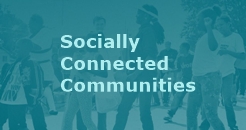 Socially Connected Communities - solutions for social isolation
Socially Connected Communities - solutions for social isolation
From a report by Healthy Places by Design
Social isolation is not a personal choice or individual problem, but one that is rooted in community design, social norms, and systemic injustices.
In recent decades, people around the world have experienced soaring rates of social isolation, with profound impacts on health and well-being. Far from being a personal choice, social isolation stems from community designs and systemic injustices that keep people and neighbourhoods apart.
We must reshape our communities in ways that support meaningful social connection among residents, improve trust between neighbours, and strengthen an overall sense of belonging and community. From architects to educators, faith leaders to health providers, local governments to grant-makers—we all can play a part in creating opportunities that build relationships between neighbours, improve trust, and foster an overall sense of community.
Social well-being refers to the strength of a person’s relationships and social networks. It is strongly linked to social inclusion and a sense of belonging. People living in socially connected communities are more likely to thrive because they feel safe, welcome, and trust each other and their government. Trusting and meaningful relationships enhance our mental, physical, and emotional health and well-being. In fact, strong social connections and networks can boost a person’s lifespan by 50 percent1.
Imagine a socially connected community where people know and trust their neighbours and people from different neighbourhoods. Where they are motivated and supported (through fair processes and practices) to be civically engaged. Where structures, policies, and relationships connect residents to important services, resources, and inclusive spaces. And where, through various signals, people see themselves represented and feel welcomed in their community. It is more important than ever for local leaders to work with residents to create socially connected communities. This priority can help address past and current traumas due to structural and systemic oppression, and build more cohesive, resilient, and equitable communities.
Currently, isolation is being defined, discussed, and addressed primarily through an individual lens rather than a systemic one. This can be seen most vividly by the frequent conflation of the terms social isolation and loneliness. While loneliness describes the individual experience and perception of being alone, we must move past this individual frame to find the contextual, root causes of social isolation in order to identify community-level and structural factors that can be changed to address them.
What are the recommendations?
1. Design, Maintain, and Activate Inclusive Public Spaces
-
Co-create inclusive, healthy public spaces - the role of the "welcome mat." e.g. parks, libraries, access to government, use of schools, community centres, etc. Work with residents to determine how public spaces would best help them connect.
-
Design safe places for all ages to gather e.g. co-locate adult and child care centres together.
-
Equitably maintain the quality of public spaces.
-
Activate public spaces to encourage healthy social interaction e.g. open schoolyards during out-of-school hours, combine library tickets with passes to museums, theatres, etc.
2. Prioritize Connection in Transportation Systems
-
Think "people first". Different types of transportation modes can provide opportunities for meeting others, starting conversations, and building trust in neighbours and institutions. They also enhance health and well-being and reduce emissions.
-
Use policy levers to promote health and equity.
-
Support elements that enhance public life e.g. play streets—a temporary closure of public streets to create safe spaces for active play, Little Free Libraries at public bus stops, transforming trails into walkable art galleries, etc.
3. Construct Housing Environments that Build Community
-
Strengthen and safeguard inclusive, affordable housing.
-
Include spaces specifically designed for gatherings. Work with local healthcare providers to use social prescribing to encourage people experiencing health needs, including social isolation, to use these community assets. Co-locate parks and affordable housing wherever possible.
-
Zone to encourage diversity. Mixed-income housing creates a diverse community while reducing the stigma of "public housing." Mixed-use developments improve access to various services and resources, which reduces transportation-related challenges and typically increases street-level activity.
4. Invest in Inclusive Practices and Community-led Solutions
-
Shift power to community members e.g. participatory budgeting. Meaningful community engagement not only results in more inclusive and welcoming solutions but participation itself also increases a sense of belonging and can inspire other community members to engage in collaborative efforts.
-
Elevate practices rooted in culture. Collectively, arts and culture enable understanding of the past and envisioning of a shared, more equitable future.
-
Harness creative communication channels. Use social media and video platforms to expand conversations and networks and advance community-led change. Reframe the conversation around root causes and a desired future (socially connected communities), rather than the problem at hand (social isolation).
-
Create universal broadband access.
5. Make Social Connectedness a Community Norm
-
Use a Social in All Policies framework. By consistently weaving social well-being into policy priority areas, local leaders can strengthen the social fabric of their communities and the country.
-
Implement trauma- and resilience-informed practices. These can be implemented within systems such as housing, justice, immigration, and others that intentionally and unintentionally exacerbate isolation.
-
Declare community values. Community leaders can and should work with residents (rather than merely for them) to declare their community as one that values all people, prioritizes dignity, honours diverse identities and cultures, and demonstrates compassion.
There are many Community Examples in the report.
Read the full report here.
1 Harmon, K. (2010, July 28). Social ties boost survival by 50 percent. Retrieved from https://www.scientificamerican.com/ A meta-study of more than 300,000 participants across all ages
Retweet about this article:
From a report by Healthy Places by Design, 01/06/2021